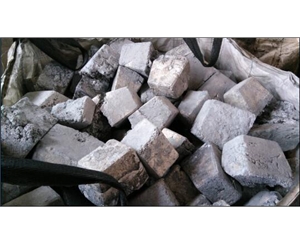Magnesium slag containing active cations and high hydration activity can be transformed into calcium silicate gel after hydration, but the [SiO 4]4- chain in the product is easily lost, forming a hybrid structure. In order to improve the durability of the gel, silica cement or its clinker and finely ground slag with a certain particle size are added. Cement-based cementitious materials have the disadvantage of self-shrinkage, so it is necessary to add pulverized expanded magnesium slag for control. Zhang et al. prepared a new type of cementitious material by using magnesium slag, gypsum, cement, fly ash, and alkaline activators. The ratio of magnesium slag to fly ash affects the performance of the product. When the ratio of magnesium slag to fly ash is 5:5, the strength and mechanical properties of the cementitious material are better, and the product performance with 10% gypsum and 15% cement is better.

Magnesium slag recycling
After recycling magnesium slag, it was found that the strength of the product was higher when the "mixing before grinding" method was used and the fine slag and magnesium slag had equal content. If three auxiliary alkali activators (calcium sulfate, sodium silicate, and NaSO4) were added, the strength performance could reach the requirement of 32 MPa composite cement. The resulting cementitious material can be used to prepare a new type of low-density, high-strength, and durable wall material with low cost, simple process, and excellent product performance, providing new ideas for the subsequent treatment of cementitious materials. Xiao et al. used homemade magnesium slag cementitious material, other additives, and EPS ultra-lightweight aggregate to make lightweight, durable, and high-strength wall materials. The compressive strength after 28 days was 6 MPa. The strength loss of the wall material after 25 freeze-thaw cycles at -25°C to 25°C was 10%, and the mass loss was less than 1%. Thus reasonable magnesium alloy scrap price afforded need to be noticed.
When the ratio of the main materials (magnesium slag, magnesium alloy powder, fly ash, iron powder, silica fume, slag, steel slag, river sand) to fiber to resin was 70-90:1-8:1-10, magnesium slag fiber-reinforced board could be produced. The material was ground to a fineness above 100 mesh, stirred for 1 minute, and then made into a blank by adding water, which was formed by rolling in stages and steam pressing for 10 hours. Currently, the modified sulfide magnesium cementitious system obtained from light-burned magnesium oxide solidifies cyanide-containing waste residue, and some of the cyanide-containing waste residue participates in the cement hydration process, hindering the generation of naphthalene chloride and providing a skeleton effect to improve strength. The process and mechanism of solidifying cyanide-containing waste residue in magnesium solid waste cementitious materials can be studied in the future to achieve the scientific disposal of hazardous waste.
During the hardening of concrete, it is easy to shrink due to water loss and cool due to temperature reduction. In order to control the shrinkage cracks of concrete, expansion agents should be added to improve durability. Metallurgical slag magnesium slag or steel slag is often used as this expansion agent. After the calcium-magnesium oxide in magnesium slag undergoes hydration reaction, it obtains expansive hydroxides with a volume expansion rate of 97.9% and 148%. When magnesium slag is used alone and cured in water for 7 days, it cannot meet the requirements of standard concrete expansion agents. It is necessary to add activators to improve the performance of magnesium slag, such as gypsum to activate the volcanic ash activity of magnesium slag, and lime to accelerate the hydration process to improve its early expansion performance. After adding magnesium slag, it can meet the strength and ultimate expansion rate requirements of concrete expansion agents in various curing ages. In addition, the factors affecting the modified asphalt of magnesium slag include powder-to-binder ratio, particle size, and magnesium slag content. The powder-to-binder ratio has a greater impact on the performance of modified asphalt, followed by magnesium slag content and particle size. The order of improved asphalt adhesion performance is talc powder > magnesium slag > limestone powder. In addition, the surface morphology of magnesium slag and the initial dosage of magnesium slag both affect the adhesion of asphalt. As the amount of magnesium slag increases, the corresponding influence becomes more significant. However, magnesium slag asphalt pavement is prone to cracking and has low strength, so magnesium slag has not been widely used in the field of building materials.